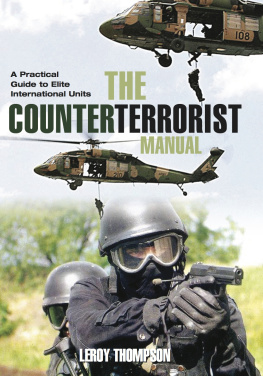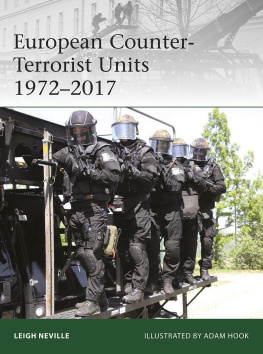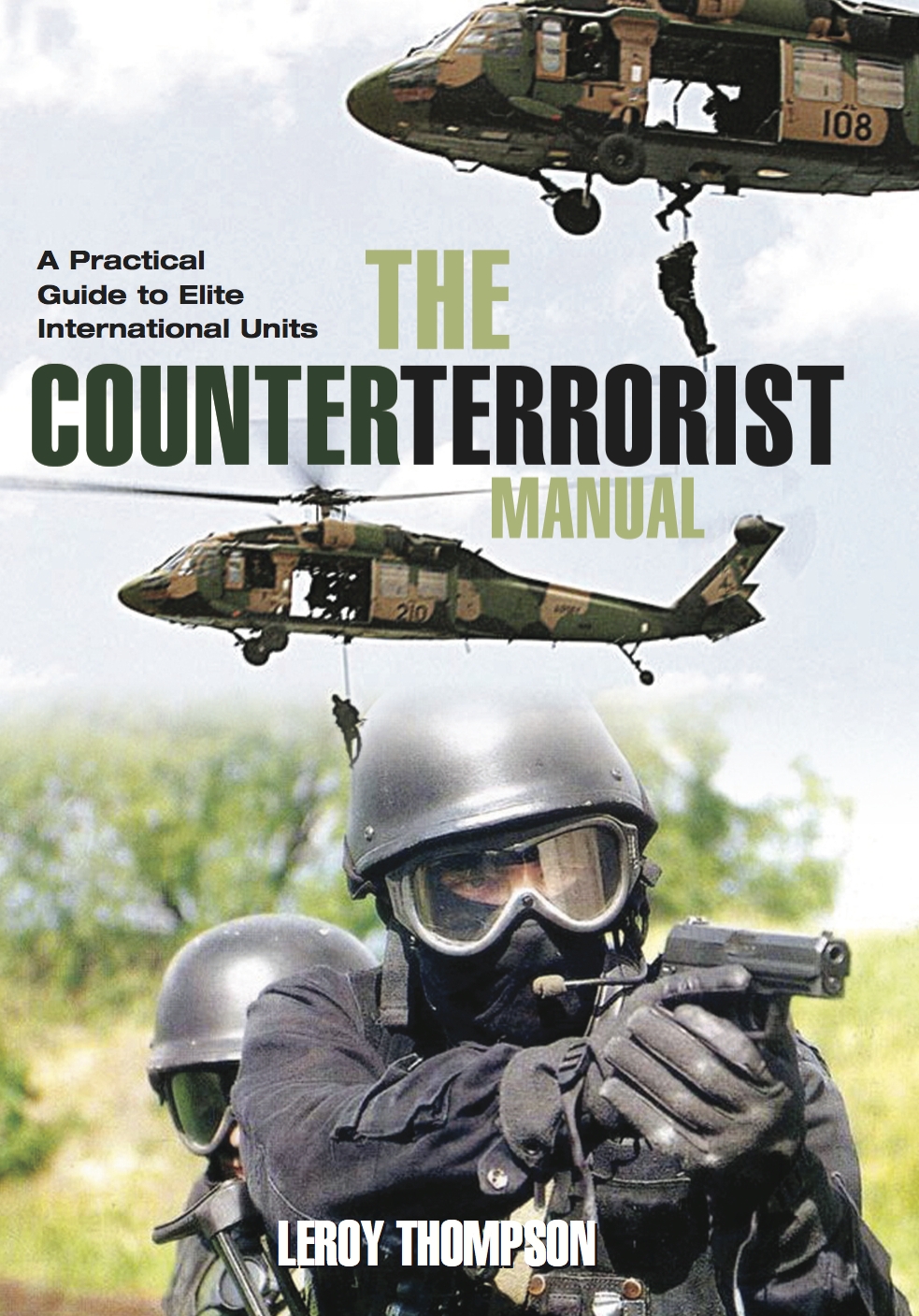Suggested reading
Beckwith, Col. Charlie A., Delta Force (Harcourt Brace Jovanovich, San Diego, 1983)
Bennett, Richard M., Elite Forces: An Encyclopedia of the Worlds Most Formidable Secret Armies (Virgin Books, London, 2003)
Camsell, Don, Black Water: A Life in the Special Boat Service (Lewis International, 2000)
Cohen, Aaron, Brotherhood of Warriors (Harper Collins, New York, 2008)
Coulson, Danny O., No-Heroes: Inside the FBIs Secret Counter-Terror Force (Pocket Books, New York, 1999)
Courtois, Jean-Louis, Le Raid: LUnit Dlite de la Police Franaise
(Pygmalion, Paris, 1999)
Le RAID: LUltime Recours (Editions Crepin-LeBlond, 2000)
Davies, Barry, Fire Magic: Hijack at Mogadishu (Bloomsbury, London, 1994)
SAS, Shadow Warriors of the 21st Century (Lewis International, Miami, FL, 2002)
Deflez, Gilbert, La Brigade des Missions Impossibles (Jacques Grancher, Paris, 1979)
Gagueche, Yvon. GIGN, GSPR, EPIGN: Gendarmes de LExtreme (Editions Vanneau, Paris, 1990)
GIGN, 10 Ans DAction, Collection Action (Editions des Acacias, Nancy, 1985)
Giampietri, Luis, 41 Seconds to Freedom: An Insiders Account of the Lima Hostage Crisis 199697 (Ballantine Books, New York, 2007)
Giduck, John, Terror at Beslan (Archangel Group, Inc., Golden, CO, 2005)
Haney, Eric L., Inside Delta Force: The Story of Americas Elite Counterterrorist Unit (Delacorte Press, New York, 2002)
Harclerode, Peter, Secret Soldiers: Special Forces in the War Against Terrorism (Cassell & Company, London, 2000)
Hufnagl, Wolfdieter, Cobra: Das Gendarmerie-Einsatzkommando GEK (Motorbuch Verlag, Stuttgart, 2002)
J agdkommando: Sondereinheiten des Osterreichischen Bundesheeres (Motorbuch Verlag, Stuttgart, 2002)
Katz, Samuel M., The Elite: The True Story of Israels Secret Counterterrorist Unit
Pocket Books (New York, 1992)
The Illustrated Guide to the Worlds Top Counter-Terrorist Forces
(Concord, Hong Kong 1995)
The Illustrated Guide to the Worlds Top Naval Special Warfare Units
(Concord, Hong Kong, 2000)
Le RAID, Unite Dlite de la Police Nationale (Crepin-Leblond, Paris, 2005)
Mannucci, Enrico, In Pace e In Guera (Longanesi & C., Milan, 2004)
Marcinko, Richard, Rogue Warrior (Pocket Star Books, New York, 1992)
Micheletti, Eric, French Special Forces (Histoire & Collections, Paris, 1999)
GIGN , Histoire & Collections (Paris, 2005)
Pugliese, David. Canadas Secret Commandos: The Unauthorized Story of Joint Task
Force Two (Esprit de Corps Books, Ottawa, 2002)
Pushies, Fred J. et al., U.S . Counter-Terrorist Forces (MBI Publishing, St. Paul, MN, 2001)
Pushies, Fred J., Weapons of Delta Force (MBI Publishing, St. Paul, MN, 2002)
Ryan, Paul B., The Iranian Rescue Mission: Why It Failed (Naval Institute Press, Annapolis, 1985)
Scholzen, Reinhard. KSK: Das Kommando Spezialkrafte der Bundeswehr (Motorbuch Verlag, Stuttgart, 2004)
Southby-Tailyour, Ewen, Janes Special Forces Recognition Guide (Collins, London, 2005)
Thompson, Leroy, Hostage Rescue Manual (Greenhill, London, 2001)
The Rescuers: The Worlds Top Anti-Terrorist Units ( Paladin Press, Boulder, CO, 1986)
Tophoven. GSG 9: German Response to Terrorism (Bernard & Graf Verlag, Koblenz, 1984)
Trofimov, Yaroslav. The Siege of Mecca (Doubleday, New York, 2007)
Whitcomb, Christopher. Cold Zero: Inside the FBI Hostage Rescue Team (Little, Brown, and Co., Boston, 2001)
Williamson, Tony, Counterstrike Entebbe (Collins, London, 1976)
Chapter I
Antiterrorism: Background and Evolution
T he hijacking of airliners and attacks on El Al flights during 1968 and 1969 certainly brought the threat of terrorism to the attention of world governments. Many governments, however, viewed the threat of Middle Eastern terrorism as a primarily Israeli problem and either ignored the threat or made concessions to Palestinian groups in the hope that they would look elsewhere for targets. The September 1970 hijackings of multiple airliners from multiple countries, their landings in Jordan, and their destruction on the ground should have warned the world that the threat had become endemic and was not going to disappear. As might be expected, however, Israel, the primary target of terrorism, was the first country to see the need for units trained and ready to take action against terrorists. The May 8, 1972 hijacking of a Sabena airliner and its landing in Tel Aviv set the stage for a successful Israeli rescue of the passengers. Using many techniques that would later become standard with antiterrorist unitsincluding practice on a similar airliner, the use of disguise to get the rescue team close to the aircraft, and the use of deception (more than 300 Israeli soldiers posing as freed Palestinian militants on fake Red Cross buses)the Israeli team successfully killed or captured the terrorists and freed all the hostages. (An interesting side note to this rescue is that two future Israeli prime ministersEhud Barak and Benjamin Netanyahutook part in the assault. Netanyahu was wounded during the operation.) Israel had demonstrated that it was not necessary to make concessions to terrorists and that effective action could be taken if trained personnel and national resolve were present.
The scene of the 1972 Munich hostage crisis#31 Connollystrasseas it looked in March 2006; note the balconies on which the terrorists observe police activity. Note also the glass-covered stairway.
The view of the back of #31 Connollystrasse. The hostages were held in the second floor room to the right rear.
It was not until the September 1972 Munich Olympic Massacre stunned the world, however, that many countries realized that they were impotent when faced with a terrorist act. The German response to the taking of Israeli athletes was a virtual textbook study of how not to deal with a terrorist incident. Long before the Olympics, the Germans had ignored the potential threat and had not trained the Munich police to deal with a hostage incident. A police psychologist had warned of the likelihood of an incident that would play out much as the actual event transpired. Security at the Olympic Village was so lax that the terrorists were able to gain entry to the dormitory that would house Israeli athletes and reconnoiter it before the Olympics began.
Once the hostages had been taken, negotiations were carried out incompetently and offers of assistance from the Israelis, who were considered to be the most experienced antiterrorist force in the world at the time, were ignored. The attempted rescue by the German police at the Olympic Village was inept and was compromised by being broadcast live on television, a broadcast viewed by the hostage takers! The German police ignored the possibility of a rescue when the terrorists were transporting the hostages by bus to two waiting helicopters, an option many antiterrorism experts now think offered the highest likelihood of success. At Frstenfeldbruk Airport, located 15 miles out of Munich, the Germans did not deploy enough trained snipers. They had not rehearsed the operation with the helicopter crews landing the hostages to offer the snipers optimum shooting angles. The snipers lacked intelligence and didnt even have radios. All the elements were there for a disaster and those elements came together to cause the death of all of the hostages.



















